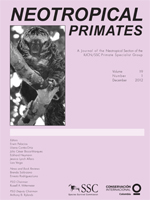Ateles hybridus brunneus is a subspecies endemic to Colombia. Its distribution has been estimated at 49,000 km2, assuming its distribution extends up to 2,000 meters above sea level (Defler, 2010). However, a new model predicts an even smaller potential distribution and habitat available, between 5,000 and 13,000 km2 (Roncancio et al., in press). Several characteristics of the variegated spider monkey make it extremely vulnerable to the loss, reduction and fragmentation of its habitat: these include its low population density, which ranges from 0.24 to 43 ind/km2 (Roncancio et al., 2010a, b) and features such as its large body mass (7–9 kg), frugivorous diet (up to 85% of the diet is composed of ripe fruit), long birth intervals (one offspring every 3–4 years), wide-ranging activity patterns (1.5–3.5 km traveled per day) and large home range (60–350 ha) (Chapman and Onderdonk, 1998; Stevenson et al., 2002; Defler et al., 2003; Link and Di Fiore, 2006; Takahashi, 2008; Urbani et al., 2008; Palacios et al., 2009; Defler, 2010).
A. hybridus is categorized as Critically Endangered (CR) (Urbani et al., 2008) and is considered one of the 25 most threatened primates in the world (Mittermeier et al., 2009). In particular, A. h. brunneus is most at risk of extinction because in addition to other threats common to all subspecies, the area of distribution for this subspecies is smaller and no national protected area contains a confirmed population of the taxon. Only the recently declared National Natural Park, Selva de Florencia, on the southern limit of the historical distribution of this subspecies (Defler, 2010), may house a population, but has never been an official record of its presence there. The nearest confirmed population is 61 km away from this area (Roncancio et al., 2010a).
In order to plan effective strategies for wildlife conservation, it is necessary to assess conservation status by measuring indicators that, compared over time, will enable the evaluation of any implemented interventions. Two of these indicators are species distribution and available habitat. Following a random sampling design, several points in the historical distribution of A. h. brunneus were visited in order to gather occurrence records to model its current distribution. Additionally, some places that could be important conservation areas for the taxon were visited (Roncanio et al, in prep).
Selva de Florencia National Natural Park is the only protected area in the historical distribution of this taxon. Ten years ago, the presence of this primate was reported near the area of the park (Castaño, 2001), but the individual recorded was in captivity and its “owner” said that the primate was captured in the park's area. Nevertheless, there was no official record of the species in the park. In order to confirm a natural population of the variegated spider monkey in Selva de Florencia National Natural Park, the staff of the park interviewed local inhabitants in the area. In November 2011 an individual living on the western zone of the park provided information about the species' presence in the protected area.
On December 8, this zone was visited by a staff from the park and individuals living in the area, and two individuals of A. h. brunneus were recorded. They were seen moving and foraging at 1,780 meters a.s.l. (5°29′43″N, -75°06′56″W). The Selva de Florencia National Natural Park is now confirmed as the only national park that protects this taxon and its southernmost population. Another important aspect lies in the fact that this park has an altitudinal distribution from 850 to 2,200 meters a.s.l. and only a limited area (10% of the park) is below 1,000 m. The fact that this remnant population is at the limit of the distribution makes this population more vulnerable. Additionally, Ateles hybridus prefers habitat from 0 to 800 meters a.s.l. (Defler, 2010), and thus suitable habitat available inside the protected area is also relatively small. The lowland section of the park is also highly affected by extractive and productive human activities and some of the lands are still under private ownership. In consequence, this park might only offer marginal habitat to this spider monkey, but, due to the loss of its preferred habitat, is a very important refuge for a population. It is necessary to acquire land adjacent to the park and restore the habitat to generate better quality habitat for this taxon.
Acknowledgments
To the Selva de Florencia National Natural Park and its staff for their interest and continuous help. To Wildlife Conservation Society and its staff for financial and technical support, and to the United States Fish and Wildlife Service for the financial support.





